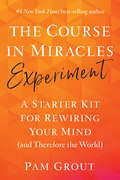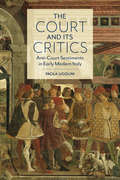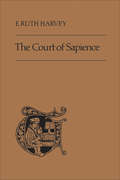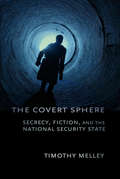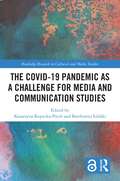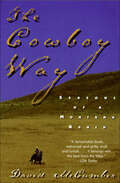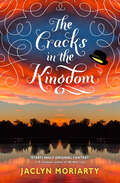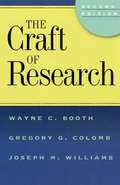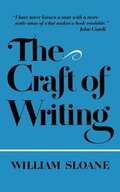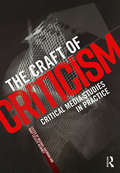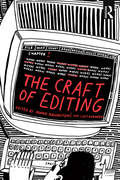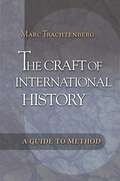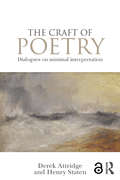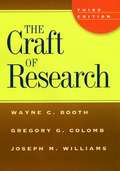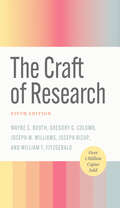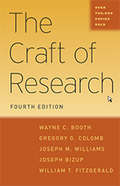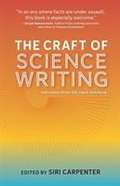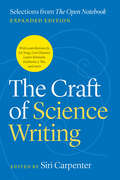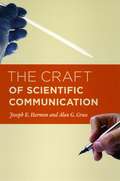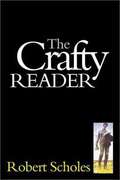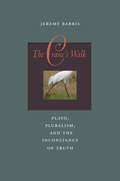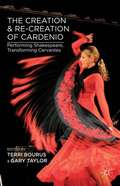- Table View
- List View
The Course in Miracles Experiment: A Starter Kit for Rewiring Your Mind (and Therefore the World)
by Pam GroutACIM, the Fun Version! A real-world rewrite of the lessons of A Course in Miracles by the #1 New York Times best-selling author of E-Squared.A Course in Miracles is profound, deeply moving, and as boring to read as a bookshelf assembly manual.Ask for a show of hands at any self-help gathering, and 95 percent will happily admit to owning the dense blue book that's a famous resource for spiritual transformation. Ask the obvious follow-up, "How many have actually read it?" and all but a smattering of hands go down. It's as if everyone wants the miracles, the forgiveness, and the mind shifts, but they just can't bear its ponderous heaviness. Pam Grout to the rescue! Her new book is for all those still struggling with the Course. Grout offers a modern-day rewrite of the 365-lesson workbook-the text at the heart of the Course. Unlike the original, it's user-friendly, accessible and easy for everyone to understand.In daily lessons with titles like "The Home Depot of Spiritual Practices" and "Transcending the Chatty Asshat in My Head," Grout drills down to the Course's essential message and meaning, grounding it in the context of everyday life in a way that's bound to stick. The lessons here blend eternal truths with pop culture and personal stories that are laugh-out-loud funny and deeply soul-stirring, often at the same time. You won't be tempted to use this Course in Miracles as a doorstop. You'll want to use it, every day, to change your life.
The Court and Its Critics: Anti-Court Sentiments in Early Modern Italy (Toronto Italian Studies)
by Paola UgoliniAnti-courtly discourse furnished a platform for discussing some of the most pressing questions of early modern Italian society. The court was the space that witnessed a new form of negotiation of identity and prestige, the definition of masculinity and of gender-specific roles, the birth of modern politics and of an ethics based on merit and on individual self-interest. The Court and Its Critics analyzes anti-courtly critiques using a wide variety of sources including manuals of courtliness, dialogues, satires, and plays, from the mid-fifteenth to the early seventeenth century. The book is structured around four key figures that embody different features of anti-courtly sentiments. The figure of the courtier shows that sentiments against the court were present even among those who apparently benefitted from such a system of power. The court lady allows an investigation of the intertwining between anti-courtliness and anti-feminism. The satirist and the shepherd of pastoral dramas are investigated as attempts to fashion two different forms of a new self for the court intellectual.
The Court of Sapience
by Elizabeth Ruth HarveyThe medieval English allegorical poem, The Court of Sapience, was written in the middle of the fifteenth century by an unknown author. It is best described as an encyclopaedia: in the allegory the poet describes the nature and activities of wisdom in all its aspects. He includes a moving account of the fall of a man and his restoration by divine wisdom; then he leads his dreamer through a landscape where all the traditional beauties of nature are catalogued and assigned their properties. The visit to the castle of Sapience, inhabited by all the branches of learning and the seven restorative virtues, completes the poem as we have it. The first edition was an early production of Caxton's press, and it was reprinted by his successor, Wynkyn de Worde. This is a new edition of Caxton's text of the poem. Variant readings from the extant manuscripts have investigated in detail and are discussed in the lengthy introduction and extensive commentary. The poem is an attractive work in itself, and has been admired by C.S. Lewis and other modern critics. It is also a valuable witness to the taste of the early Tudor period.
The Covert Sphere: secrecy, fiction, and the national security state
by Timothy MelleyIn December 2010 the U.S. Embassy in Kabul acknowledged that it was providing major funding for thirteen episodes of Eagle Four-a new Afghani television melodrama based loosely on the blockbuster U.S. series 24. According to an embassy spokesperson, Eagle Four was part of a strategy aimed at transforming public suspicion of security forces into something like awed respect. Why would a wartime government spend valuable resources on a melodrama of covert operations? The answer, according to Timothy Melley, is not simply that fiction has real political effects but that, since the Cold War, fiction has become integral to the growth of national security as a concept and a transformation of democracy. In The Covert Sphere, Melley links this cultural shift to the birth of the national security state in 1947. As the United States developed a vast infrastructure of clandestine organizations, it shielded policy from the public sphere and gave rise to a new cultural imaginary, "the covert sphere." One of the surprising consequences of state secrecy is that citizens must rely substantially on fiction to "know," or imagine, their nation's foreign policy. The potent combination of institutional secrecy and public fascination with the secret work of the state was instrumental in fostering the culture of suspicion and uncertainty that has plagued American society ever since-and, Melley argues, that would eventually find its fullest expression in postmodernism. The Covert Sphere traces these consequences from the Korean War through the War on Terror, examining how a regime of psychological operations and covert action has made the conflation of reality and fiction a central feature of both U.S. foreign policy and American culture. Melley interweaves Cold War history with political theory and original readings of films, television dramas, and popular entertainments-from The Manchurian Candidate through 24-as well as influential writing by Margaret Atwood, Robert Coover, Don DeLillo, Joan Didion, E. L. Doctorow, Michael Herr, Denis Johnson, Norman Mailer, Tim O'Brien, and many others.
The Covid-19 Pandemic as a Challenge for Media and Communication Studies (Routledge Research in Cultural and Media Studies)
by Katarzyna Kopecka-PiechThis truly interdisciplinary volume brings together a diverse group of scholars to explore changes in the significance of media and communication in the era of pandemic. The book answers two interrelated questions: how media and communication reality changed during the first wave of the COVID-19 pandemic, and how media and communication were effectively studied during this time. The book presents changes in media and communication in three areas: media production, media content, and media usage contexts. It then describes the theoretical and practical, methodological, technical, organizational, and ethical challenges in conducting research in circumstances of sudden change in research conditions, emergency situations and developing crises. Drawing on various theoretical studies and empirical research, the volume illustrates the principles and results of applying diverse research methods to the changing role of media in a pandemic and offers good practices and guidance to address the problems in implementing research projects in a time of sudden difficulties and challenges. This diverse and interdisciplinary book will be of significance to scholars and researchers in media studies, communication studies, research methods, sociology, anthropology, and cultural studies.
The Cowboy Way: Seasons of a Montana Ranch
by David McCumberIn February of his forty-fourth year, journalist David McCumber signed on as a hand on rancher Bill Galt's expansive Birch Creek spread in Montana. The Cowboy Way is an enthralling and intensely personal account of his year spent in open country—a book that expertly weaves together past and present into a vibrant and colorful tapestry of a vanishing way of life. At once a celebration of a breathtaking land both dangerous and nourishing, and a clear-eyed appreciation of the men—and women—who work it, David McCumber's remarkable story forever alters our long-held perceptions of the "Roy Rogers" cowboy with real-life experiences and hard economic truths.In February of his forty-fourth year, journalist David McCumber signed on as a hand on rancher Bill Galt's expansive Birch Creek spread in Montana. The Cowboy Way is an enthralling and intensely personal account of his year spent in open country—a book that expertly weaves together past and present into a vibrant and colorful tapestry of a vanishing way of life. At once a celebration of a breathtaking land both dangerous and nourishing, and a clear-eyed appreciation of the men—and women—who work it, David McCumber's remarkable story forever alters our long-held perceptions of the "Roy Rogers" cowboy with real-life experiences and hard economic truths.
The Crab Alphabet Book
by Jerry PallottaWith his signature humor and amazing facts, best-selling author Jerry Pallotta offers a decapod for every letter of the alphabet.Meet dozens of crustaceans--and a few bonus animals--with engaging text and a laugh-out-loud narrative, from A (Arrow Crab) to E (exoskeleton) to I (Imocaris, a kind of fossil scientists believe to be the first crab on earth) to Z (Zebra Hermit Crabs, which have a hard covering on their legs and claws, but their body is soft). Readers of all ages will be entertained (and learning!) with every page turn.
The Cracks in the Kingdom: Book 2 Of The Colors Of Madeleine (The Colors of Madeleine #2)
by Jaclyn MoriartyThe sequel to A Corner of White. “Mixed in with the regal intrigue is a complex, moving look at families, friendship, and loss . . . thrilling.” —School Library Journal (starred review)Picking up where A Corner of White left off, Elliot is more determined to find his father than ever, now that he knows he’s still alive. But first he must help Princess Ko find her own missing family, as the secret search for the royals of Cello begins. As part of the Royal Youth Alliance, Elliot will travel all over the Kingdom of Cello looking for any clue or detail or spell that could bring them (and maybe his own father) home. But once he learns that the royal family has been trapped in the World all this time, with no memory of their former lives, his real value to the Alliance becomes clear: He’s the only one with a connection to the World, through Madeleine.Together, through notes, letters, and late nights, Elliot and Madeleine must find a way to travel across worlds and bring missing loved ones home. The stakes are high, the writing both hilarious and heart-poundingly suspenseful, and the experience of reading it, sheer pleasure.“Madcap, whimsical, smart and even heartbreaking . . . By turns coming-of-age and wild adventure, this volume complicates the characters, expands the worldbuilding and sets things up for a grand finish in the trilogy closer . . . even better than the first.” —Kirkus Reviews (starred review)“Full of clever invention and intrigue, excellent surprises, and all the sophisticated wit Moriarty’s fans expect.” —The Horn Book (starred review)
The Craft Of Research
by Joseph M. Williams Gregory G. Colomb Wayne BoothSince 1995, more than 150,000 students and researchers have turned to The Craft of Research for clear and helpful guidance on how to conduct research and report it effectively . Now, master teachers Wayne C. Booth, Gregory G. Colomb, and Joseph M. Williams present a completely revised and updated version of their classic handbook. <p><p> Like its predecessor, this new edition reflects the way researchers actually work: in a complex circuit of thinking, writing, revising, and rethinking. It shows how each part of this process influences the others and how a successful research report is an orchestrated conversation between a researcher and a reader. Along with many other topics, The Craft of Research explains how to build an argument that motivates readers to accept a claim; how to anticipate the reservations of thoughtful yet critical readers and to respond to them appropriately; and how to create introductions and conclusions that answer that most demanding question, "So what?" <p> Celebrated by reviewers for its logic and clarity, this popular book retains its five-part structure. Part 1 provides an orientation to the research process and begins the discussion of what motivates researchers and their readers. Part 2 focuses on finding a topic, planning the project, and locating appropriate sources. This section is brought up to date with new information on the role of the Internet in research, including how to find and evaluate sources, avoid their misuse, and test their reliability. <p> Part 3 explains the art of making an argument and supporting it. The authors have extensively revised this section to present the structure of an argument in clearer and more accessible terms than in the first edition. New distinctions are made among reasons, evidence, and reports of evidence. The concepts of qualifications and rebuttals are recast as acknowledgment and response. Part 4 covers drafting and revising, and offers new information on the visual representation of data. Part 5 concludes the book with an updated discussion of the ethics of research, as well as an expanded bibliography that includes many electronic sources. <p> The new edition retains the accessibility, insights, and directness that have made The Craft of Research an indispensable guide for anyone doing research, from students in high school through advanced graduate study to businesspeople and government employees. The authors demonstrate convincingly that researching and reporting skills can be learned and used by all who undertake research projects. <p> New to this edition: <p> Extensive coverage of how to do research on the internet, including how to evaluate and test the reliability of sources <p> New information on the visual representation of data <p> Expanded bibliography with many electronic sources
The Craft Of Writing
by William SloaneA writer, editor, publisher, and teacher, Sloane presents his ideas on writing and on teaching the craft of writing in chapters derived chiefly from lectures presented at the Bread Loaf Writers' Conference.
The Craft of Criticism: Critical Media Studies in Practice
by Mary Celeste Kearney Michael KackmanWith contributions from 30 leading media scholars, this collection provides a comprehensive overview of the main methodologies of critical media studies. Chapters address various methods of textual analysis, as well as reception studies, policy, production studies, and contextual, multi-method approaches, like intertextuality and cultural geography. Film and television are at the heart of the collection, which also addresses emergent technologies and new research tools in such areas as software studies, gaming, and digital humanities. Each chapter includes an intellectual history of a particular method or approach, a discussion of why and how it was used to study a particular medium or media, relevant examples of influential work in the area, and an in-depth review of a case study drawn from the author's own research. Together, the chapters in this collection give media critics a complete toolbox of essential critical media studies methodologies.
The Craft of Editing
by Adnan Mahmutović Lucy DurneenThe Craft of Editing offers a rare insight into the unique dynamic between author and editor. In this illuminating book, Adnan Mahmutović and Lucy Durneen lead a cohort of industry experts to bring transparency to the mystique that often surrounds the craft and practice of editing. Using genuine case studies from published works – including annotated manuscripts – this book prepares writers for potential dialogue and critique from editors. The Craft of Editing follows the journey from rough draft to publication, an essential part of any writing experience, while showing the singular and authentic approach each editor takes. Using original pitches, debates, emails, and instant messages to shed light on the collaboration between authors and editors, The Craft of Editing is an indispensable tool to creative writers and students alike.
The Craft of Historical Research: A Practical Guide from Start to Finish
by Isaac LandComplete with practical advice and helpful guidance, this book is an approachable manual perfect for budding historians at all levels. Its worksheets, which focus on framing realistic goals and heading off common misunderstandings, will aid independent work and make check-ins with the advisor more candid and productive. Drawing on examples from six continents, as well as primary sources ranging from cuneiform tablets to emails, students will learn about the effective deployment of quotations, footnotes, maps, graphs, images, and data visualizations. Throughout the book, emphasis is placed on how the student can formulate, support, and revise their claims in a historical project with a skeptical reader in mind.
The Craft of International History: A Guide to Method
by Marc TrachtenbergThis is a practical guide to the historical study of international politics. The focus is on the nuts and bolts of historical research--that is, on how to use original sources, analyze and interpret historical works, and actually write a work of history. Two appendixes provide sources sure to be indispensable for anyone doing research in this area. The book does not simply lay down precepts. It presents examples drawn from the author's more than forty years' experience as a working historian. One important chapter, dealing with America's road to war in 1941, shows in unprecedented detail how an interpretation of a major historical issue can be developed. The aim throughout is to throw open the doors of the workshop so that young scholars, both historians and political scientists, can see the sort of thought processes the historian goes through before he or she puts anything on paper. Filled with valuable examples, this is a book anyone serious about conducting historical research will want to have on the bookshelf.
The Craft of Poetry: Dialogues on Minimal Interpretation
by Derek Attridge Henry StatenThis book presents an innovative format for poetry criticism that its authors call "dialogical poetics." This approach shows that readings of poems, which in academic literary criticism often look like a product of settled knowledge, are in reality a continual negotiation between readers. But Derek Attridge and Henry Staten agree to rein in their own interpretive ingenuity and "minimally interpret" poems – reading them with careful regard for what the poem can be shown to actually say, in detail and as a whole, from opening to closure. Based on a series of emails, the book explores a number of topics in the reading of poetry, including historical and intellectual context, modernist difficulty, the role of criticism, and translation. This highly readable book will appeal to anyone who enjoys poetry, offering an inspiring resource for students whilst also mounting a challenge to some of the approaches to poetry currently widespread in the academy.
The Craft of Research (3rd edition)
by Joseph M. Williams Wayne C. Booth Gregory G. ColombWith more than 200,000 copies in print, The Craft of Research is the unrivaled resource for researchers at every level, from first-year undergraduates to research reporters at corporations and government offices. Now, seasoned researchers and educators Gregory G. Colomb and Joseph M. Williams present an updated third edition of their classic handbook, whose first and second editions were written in collaboration with the late Wayne C. Booth. The Craft of Research explains how to build an argument that motivates readers to accept a claim; how to anticipate the reservations of readers and to respond to them appropriately; and how to create introductions and conclusions that answer that most demanding question, "So what?"
The Craft of Research, Fifth Edition (Chicago Guides to Writing, Editing, and Publishing)
by Joseph M. Williams Wayne C. Booth Gregory G. Colomb Joseph Bizup William T. FitzGeraldA thoroughly updated edition of a beloved classic that has guided generations of researchers in conducting effective and meaningful research. With more than a million copies sold since its first publication, The Craft of Research has helped generations of researchers at every level—from high-school students and first-year undergraduates to advanced graduate students to researchers in business and government. Conceived by seasoned researchers and educators Wayne C. Booth, Gregory G. Colomb, and Joseph M. Williams, this fundamental work explains how to choose significant topics, pose genuine and productive questions, find and evaluate sources, build sound and compelling arguments, and convey those arguments effectively to others. While preserving the book’s proven approach to the research process, as well as its general structure and accessible voice, this new edition acknowledges the many ways research is conducted and communicated today. Thoroughly revised by Joseph Bizup and William T. FitzGerald, it recognizes that research may lead to a product other than a paper—or no product at all—and includes a new chapter about effective presentations. It features fresh examples from a variety of fields that will appeal to today’s students and other readers. It also accounts for new technologies used in research and offers basic guidelines for the appropriate use of generative AI. And it ends with an expanded chapter on ethics that addresses researchers’ broader obligations to their research communities and audiences as well as systemic questions about ethical research practices. This new edition will be welcomed by a new and more diverse generation of researchers.
The Craft of Research, Fourth Edition (Chicago Guides to Writing, Editing, and Publishing)
by Joseph M. Williams Wayne C. Booth Gregory G. Colomb Joseph Bizup William T. FitzgeraldWith more than three-quarters of a million copies sold since its first publication, The Craft of Research has helped generations of researchers at every level--from first-year undergraduates to advanced graduate students to research reporters in business and government--learn how to conduct effective and meaningful research. Conceived by seasoned researchers and educators Wayne C. Booth, Gregory G. Colomb, and Joseph M. Williams, this fundamental work explains how to find and evaluate sources, anticipate and respond to reader reservations, and integrate these pieces into an argument that stands up to reader critique. The fourth edition has been thoroughly but respectfully revised by Joseph Bizup and William T. FitzGerald. It retains the original five-part structure, as well as the sound advice of earlier editions, but reflects the way research and writing are taught and practiced today. Its chapters on finding and engaging sources now incorporate recent developments in library and Internet research, emphasizing new techniques made possible by online databases and search engines. Bizup and FitzGerald provide fresh examples and standardized terminology to clarify concepts like argument, warrant, and problem. Following the same guiding principle as earlier editions--that the skills of doing and reporting research are not just for elite students but for everyone--this new edition retains the accessible voice and direct approach that have made The Craft of Research a leader in the field of research reference. With updated examples and information on evaluation and using contemporary sources, this beloved classic is ready for the next generation of researchers.
The Craft of Science Writing: Selections from The Open Notebook
by Siri CarpenterThis book is a collection of indispensable articles on the craft of science writing as told by some of the most skillful science journalists working today. These selections are a wealth of journalistic knowledge from The Open Notebook, the online community that has been a primary resource for science journalists and aspiring science writers for the last decade. The Craft of Science Writing gives you a crew of accomplished, encouraging friends to whisper over your shoulder as you work. In these pages, you'll find interviews with leading journalists offering behind-the-scenes inspiration, as well as in-depth essays on the craft offering practical advice.
The Craft of Science Writing: Selections from “The Open Notebook,” Expanded Edition (Chicago Guides to Writing, Editing, and Publishing)
by Siri CarpenterA deeply sourced, inclusive guide to all aspects of science writing with contributions from some of the most skilled and award-winning authors working today. Science writing has never been so critical to our world, and the demands on writers have never been greater. On any given day, a writer might need to explain the details of AI, analyze developments in climate change research, or serve as a watchdog helping to ensure the integrity of the scientific enterprise. At the same time, writers must spin tales that hook and keep readers, despite the endless other demands on their attention. How does one do it? The Craft of Science Writing is the authoritative guide. With pieces curated from the archives of science writers’ go-to online resource, The Open Notebook, this book explores strategies for finding and shaping story ideas, pitching editors, and building a specialty in science writing. It delves into fundamental skills that every science writer must learn, including planning their reporting; identifying, interviewing, and quoting sources; organizing interview notes; and crafting stories that engage and inform audiences. This expanded edition includes new introductory material and nine new essays focusing on such topics as how to establish a science beat, how to find and use quotes, how to critically evaluate scientific claims, how to use social media for reporting, and how to do data-driven reporting. In addition, there are essays on inclusivity in science writing, offering strategies for eradicating ableist language from stories, working with sensitivity readers, and breaking into English-language media for speakers of other languages. Through interviews with leading journalists offering behind-the-scenes inspiration as well as in-depth essays on the craft offering practical advice, readers will learn how the best science stories get made, from conception to completion. Contributors: Humberto Basilio, Siri Carpenter, Jeanne Erdmann, Dan Ferber, Tina Casagrand Foss, Geoffrey Giller, Laura Helmuth, Jane C. Hu, Alla Katsnelson, Roxanne Khamsi, Betsy Ladyzhets, Jyoti Madhusoodanan, Amanda Mascarelli, Robin Meadows, Kate Morgan, Tiên Nguyễn, Michelle Nijhuis, Aneri Pattani, Rodrigo Pérez Ortega, Mallory Pickett, Kendall Powell, Tasneem Raja, Sandeep Ravindran, Marion Renault, Julia Rosen, Megha Satyanarayana, Christina Selby, Knvul Sheikh, Abdullahi Tsanni, Alexandra Witze, Katherine J. Wu, Wudan Yan, Ed Yong, Rachel Zamzow, Sarah Zhang, and Carl Zimmer
The Craft of Scientific Communication (Chicago Guides To Writing, Editing, And Ser.)
by Alan G. Gross Joseph E. HarmonThe ability to communicate in print and person is essential to the life of a successful scientist. But since writing is often secondary in scientific education and teaching, there remains a significant need for guides that teach scientists how best to convey their research to general and professional audiences. The Craft of Scientific Communication will teach science students and scientists alike how to improve the clarity, cogency, and communicative power of their words and images.In this remarkable guide, Joseph E. Harmon and Alan G. Gross have combined their many years of experience in the art of science writing to analyze published examples of how the best scientists communicate. Organized topically with information on the structural elements and the style of scientific communications, each chapter draws on models of past successes and failures to show students and practitioners how best to negotiate the world of print, online publication, and oral presentation.
The Crane's Walk: Plato, Pluralism, and the Inconstancy of Truth
by Jeremy BarrisIn The Crane's Walk, Jeremy Barris seeks to show that we can conceive and live with a pluralism of standpoints with conflicting standards for truth--with the truth of each being entirely unaffected by the truth of the others. He argues that Plato's work expresses this kind of pluralism, and that this pluralism is important in its own right, whether or not we agree about what Plato's standpoint is.The longest tradition of Plato scholarship identifies crucial faults in Plato's theory of Ideas. Barris argues that Plato deliberately displayed those faults, because he wanted to demonstrate that basic kinds of error or illogic have dimensions that are crucial to the establishing of truth. These dimensions legitimate a paradoxical coordination of logically incompatible conceptions of truth. Connecting this idea with emerging currents of Plato scholarship, he emphasizes, in addition to the dialogues' arguments, the importance of their nonargumentative features, including drama, myths, fictions, anecdotes, and humor. These unanalyzed nonargumentative features function rigorously, as a lever with which to examine the enterprise of rational argument itself, without presupposing its standards or illegitimately assimilating any position to the standards of another.Today, communities are torn apart by conflicts within and between a host of different pluralist and absolutist commitments. The possibility developed in this book-a coordination of absolute and relative truth that allows an understanding of some relativist and some absolutist positions as being fully legitimate and as capable of existing in a relation to their opposites-may contribute to perspectives for resolving these conflicts.
The Creation And Re-creation Of Cardenio
by Gary Taylor Terri BourusDid Shakespeare really join John Fletcher to write Cardenio, a lost play based on Don Quixote? With an emphasis on the importance of theatrical experiment, a script and photos from Gary Taylor's recent production, and essays by respected early modern scholars, this book will make a definitive statement about the collaborative nature of Cardenio.
The Creation of Lancastrian Kingship
by Jenni NuttallThe arguments used to justify the deposition of Richard II in 1399 created new forms of political discussion which developed alongside new expectations of kingship itself and which shaped political action and debate for centuries to come. This interdisciplinary study analyses the political language and literature of the early Lancastrian period, particularly the reigns of Henry IV (1399–1413) and Henry V (1413–1422). Lancastrian authors such as Thomas Hoccleve and the authors of the anonymous works Richard the Redeless, Mum and the Sothsegger and Crowned King made creative use of languages and idioms which were in the process of escaping from the control of their royal masters. In a study that has far-reaching implications for both literary and political history, Jenni Nuttall presents a fresh understanding of how political language functions in the late medieval period.
